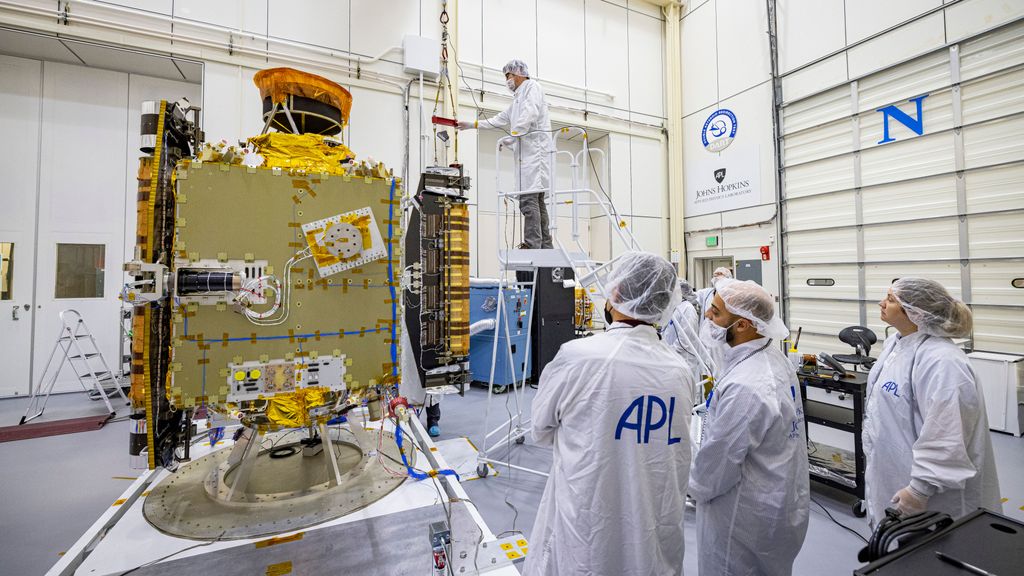
By Lee Bullen
NASA’s DART spacecraft launched from California this week to possibly “defend the world” against asteroids and comet threats.
The Double Asteroid Redirection Test (DART), which the space agency describes as “the world’s first full-scale mission to test technology for defending Earth against potential asteroid or comet hazards,” launched Nov. 24 on a SpaceX Falcon 9 rocket from the Vandenberg Space Force Base in California, NASA said in a statement.
The space agency said DART, built and managed by the Johns Hopkins Applied Physics Laboratory (APL) in Maryland, “will impact a known asteroid that is not a threat to Earth,” but the experimental technology could be used to one day defend Earth from external threats.
“DART’s one-way trip is to the Didymos asteroid system, which comprises a pair of asteroids,” NASA said. DART’s target is the moonlet Dimorphos, which is approximately 530 feet in diameter. The moonlet orbits Didymos, which is approximately 2,560 feet in diameter.
The “Armageddon”-style plan is to crash the spacecraft into Dimorphos and slightly change its path.
NASA said the impact should alter the asteroid’s movement so it can be measured by experts using telescopes on the ground.
“DART will show that a spacecraft can autonomously navigate to a target asteroid and intentionally collide with it, a method of deflection called kinetic impact. The test will provide important data to help better prepare for an asteroid that might pose an impact hazard to Earth, should one ever be discovered,” NASA said.
“LICIACube, a CubeSat riding with DART and provided by the Italian Space Agency (ASI), will be released prior to DART’s impact to capture images of the impact and the resulting cloud of ejected matter,” the U.S. space agency added.
About four years after DART’s impact, the European Space Agency’s Hera project will carry out a survey with “particular focus on the crater left by DART’s collision and a precise determination of Dimorphos’ mass.”
“DART is turning science fiction into science fact and is a testament to NASA’s proactivity and innovation for the benefit of all,” NASA Administrator Bill Nelson said.
“In addition to all the ways NASA studies our universe and our home planet, we’re also working to protect that home, and this test will help prove out one viable way to protect our planet from a hazardous asteroid should one ever be discovered that is headed toward Earth.”
The spacecraft is expected to intercept the Didymos system between Sept. 26 and Oct. 1, 2022, when it will intentionally crash into Dimorphos at roughly four miles per second.

Experts estimate that the impact will shorten Dimorphos’ orbit around Didymos by several minutes.
“Researchers will precisely measure that change using telescopes on Earth. Their results will validate and improve scientific computer models critical to predicting the effectiveness of the kinetic impact as a reliable method for asteroid deflection,” NASA said.
“We have not yet found any significant asteroid impact threat to Earth, but we continue to search for that sizable population we know is still to be found,” Lindley Johnson, planetary defense officer at NASA Headquarters, said. “Our goal is to find any possible impact, years to decades in advance, so it can be deflected with a capability like DART that is possible with the technology we currently have.”
“It is an indescribable feeling to see something you’ve been involved with since the ‘words on paper’ stage become real and launched into space,” said Andy Cheng, a DART investigation lead at Johns Hopkins APL who came up with the DART concept.
“This is just the end of the first act, and the DART investigation and engineering teams have much work to do over the next year preparing for the main event, DART’s kinetic impact on Dimorphos,” Cheng said.
Edited by Richard Pretorius and Kristen Butler
The post VIDEO: Operation As-Kicker: NASA Launches DART To Crash Into Asteroid In Planetary Defense Test appeared first on Zenger News.





